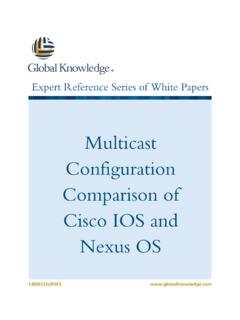Transcription of Subnetting an IP Address
1 Expert Reference Series of White Papers Subnetting an IP Address 1-800-COURSES Subnetting an IP Address Alan Thomas, CCNA, CCSI, Global Knowledge Instructor Introduction The process of Subnetting is both a mathematical process and a network design process. Mathematics drives how subnets are calculated, identified, and assigned. The network design and requirements of the organization drive how many subnets are needed and how many hosts an individual subnet needs to support. Binary basics and IPv4 Address structure were covered in part one of this two-part paper. This paper focuses on the process rules and helpful hints for learning to subnet an IPv4 Address .
2 It covers the following topics: 1. Need for subnets 2. Process for Subnetting 3. Formulas for subnet calculation 4. Examples for putting everything together 5. Variable Length Subnet Mask (VLSM) 6. Determine the subnet, usable range of host addresses, and broadcast Address for a given host . 7. Helpful tables Note: Throughout this document, the term IP Address refers to an IPv4 Address . This document does not include IPv6. IP Address Construct and Representation An IP Address is a thirty-two-bit binary number . The thirty-two bits are separated into four groups of eight bits called octets. However, an IP Address is represented as a dotted decimal number (for example: ).
3 The Need for Subnets What exactly is Subnetting ? Subnetting is taking an IP network and subdividing it into smaller IP networks called subnetworks, or subnets. Every IP network, or subnet, is a broadcast domain. A broadcast domain is a collection of devices that can receive broadcast traffic from each other. Broadcast traffic is traffic that is delivered to every device on the network. Having a single broadcast domain, or a "flat network," presents two main problems. 1. In a single large broadcast domain, there is a large amount of broadcast traffic. Broadcast traffic is very inefficient and consumes large amounts of resources, such as bandwidth, processor cycles, and memory.
4 In fact, enough broadcast traffic on a network can cause other applications, such as email, word processors, and spreadsheets, to be negatively impacted. 2. When all devices are part of the same broadcast domain, there are no protocol boundaries between devices, so implementing security policies is difficult. In other words, there is no easy way to protect one device from another device without using host -based mechanisms, such as host -based firewalls, permissions, rights, and anti-virus. These methods serve a valuable purpose, but they are not very efficient, and they can degrade performance of the host . Copyright 2014 Global Knowledge Training LLC. All rights reserved.
5 2 The solution to these problems is to break the single large broadcast domain into several smaller broadcast domains. By doing this, the number of devices connected to each broadcast domain is smaller. This reduces the amount of broadcast traffic, improving the performance of all devices on the network. Additionally, a boundary between devices is created, which greatly improves and simplifies the implementation of security policies. As an analogy, imagine a single room, and in this room are five different groups of people; one group in each corner and one group in the center. Each group of people has a microphone and is discussing a different topic. If you were a member of one of the groups, picture how difficult it would be to hear people in your group, concentrate on your topic, and share confidential information.
6 Now imagine the single room being separated into five smaller rooms. Each group now has its own room with a door and can communicate without competing with the other groups. Each person can hear and concentrate better and more easily keep confidential information within the group. The concept of dividing a large room into smaller rooms is the same as the concept of dividing a large broadcast domain (IP network) into smaller broadcast domains (subnets). The Subnetting Process In order to create IP subnets, host bits are changed to network bits . This is often called borrowing bits . It is also often referred to as taking host bits and giving them to the network.
7 By borrowing host bits , more IP subnets are created, but each subnet can support fewer hosts. To change a host bit to a network bit, the subnet mask must be changed. Remember, a binary 0 in the subnet mask means that bit is part of the host portion of an IP Address . A binary 1 in the subnet mask means that bit is part of the network portion of an IP Address . So, to change a bit from a host bit to a network bit, the binary value of the bit must be changed from 0 to 1 in the subnet mask. When calculating subnets, the following process should be used. Each step of the process will describe in detail later in this paper. 1. Determine the assigned IP Address space.
8 2. Determine the number of subnets required based on the design of the existing network, along with the structure of the organization. It is common to assign a subnet to each department within the organization. 3. Based on the class of the IP Address space and the number of required subnets, determine how many host bits need to be borrowed. Also determine how many hosts each subnet can support. 4. calculate the decimal value and prefix value of the new subnet mask. 5. Apply the subnet mask to the assigned IP Address space to calculate the network Address of the new possible subnets, the broadcast Address for each possible subnet, and the range of usable IP addresses in each possible subnet.
9 6. Assign IP addresses to all devices, including router interfaces that are connected to that subnet. Copyright 2014 Global Knowledge Training LLC. All rights reserved. 3 Formulas for Subnet Calculation There are several formulas and rules used to calculate subnets. The formulas and rules are discussed below. Possible number of Subnets To calculate the number of possible subnets, use the formula 2n, where n equals the number of host bits borrowed. For example, if three host bits are borrowed, then n=3. 23 = 8, so eight subnets are possible if three host bits are borrowed. The table below lists the powers of 2. bits Borrowed Formula Possible Subnets bits Borrowed Formula Possible Subnets 1 21 2 12 212 4,096 2 22 4 13 213 8,192 3 23 8 14 214 16,384 4 24 16 15 215 32,268 5 25 32 16 216 65,536 6 26 64 17 217 131,072 7 27 128 18 218 262,144 8 28 256 19 219 524,288 9 29 512 20 220 1,048,576 10 210 1,024 21 221 2,097,152 11 211 2,048 22 222 4,194,304 To complete the third step of the Subnetting process, determine how many host bits need to be borrowed and rewrite the formula as 2n > ( number of required subnets).
10 For example, if the number of required subnets is 18, then write the formula as 2n > 18. Solve for n by getting as close to the number of required subnets as possible without going under. In this example, n = 5 (25 = 32). This means that to create at least 18 subnets, 5 host bits must be borrowed. Possible number of Hosts per Subnet To calculate the number of possible hosts per subnet, use the formula 2h - 2, where h equals the number of host bits . The reason two addresses must be subtracted is because of the network Address and the broadcast Address . There are two ways to determine the number of host bits . 1. Determine the number of remaining host bits based on the class of Address and the number of host bits borrowed.




